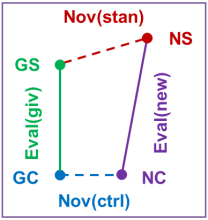This study analyzes an episode of a televised political talk show, Tucker, for evidence that speakers hyperarticulate concepts about which they express attitudes, a use of hyperarticulation that interacts with the discourse function of signaling new information. Using content analysis, the utterances of five speakers were coded on two dimensions: Evaluation (presence or absence of attitude-expression) and Novelty (new or given information in the discourse segment). To compare the resulting groups, four measures of hyperarticulation were used: speaking rate of the phrases, and duration, pitch excursion, and vowel space expansion (first and second formant values) of stressed vowels in the phrases. Group results show reliable effects for both dimensions and an interaction such that Evaluation has a greater effect than Novelty overall. Attitude-expressing items are hyperarticulated compared to a control group of neutral phrases, and within each group, new information is hyperarticulated compared to given information. Speaking rate and vowel space expansion showed these effects most reliably, followed by vowel duration. Pitch excursion was not a reliable indicator of either dimension. Individual variation contributed to the group results for all four measures, displaying very different patterns between speakers. These findings provide acoustic correlates to attitude-expression, which previous studies have not explicitly investigated and which can be applied in future work on the identification of specific types of attitudes, the perception of attitude-expression, and automatic speech recognition and synthesis.
Using acoustic measures of hyperarticulation to quantify novelty and evaluation in a corpus of political talk shows
Valerie Freeman. "Using acoustic measures of hyperarticulation to quantify novelty and evaluation in a corpus of political talk shows." MA Thesis. U of Washington, 2010.
Adviser
View PDF
(1.74 MB)
